“Discover The 3 Most Common Mistakes When Setting Up Your Shop & How You Can Avoid Them”
Warning: Even Amazon, Lowe's and Home Depot won’t give you the best price on quality tools like you think they do!
But my secret tool source can save you at least 70% off their prices.
(HINT: It’s not Harbor Freight)
I’ve created this page for people who have these questions running through their mind:
- How much money do I really need to setup a woodworking workshop?
- Is my space too small for a functional workshop?
- What are the bare minimum tools I need to create basic wood projects?
- How do I avoid bad quality tools that will just crap out on me in the first year?
- How good is good enough? Do I need to go ultra-high end to ensure a long-lasting tool?
- What are the critical factors to setup a proper workshop?
- How much money do I really need to setup a woodworking workshop?
After 20 years of woodworking and coaching other… I’ve seen enough to know:
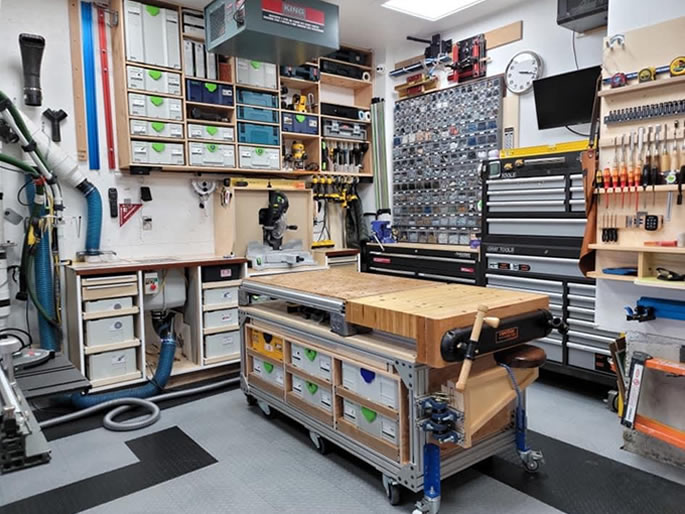


All the optimizations I’ve done… the little habits I’ve picked up… and the countless techniques, tools and layouts I’ve tried… all of that has come together to make this hobby exactly what I knew it could be.
My love for this hobby is so strong that around 5 years ago I just had to share it with others.
So I began mentoring and helping other woodworkers – from all around the world – take their creations to the next level.
And as I talked to these beginner, novice and sometimes expert wood-workers, I began to see a pattern…
Hi. My name is Ralph Chapman and I’ve been in love with woodworking for more than 25 years.
And like you, I’ve struggled with buying tools, setting up my workshop and practicing my craft. But I have to tell you… All of that frustration, planning and hard-work has paid off!
I finally have things setup just right… and I love this hobby even more than I did when I started many moons ago.
“...I’ve had a lot of BAD tools over the years.”
Its been rough on my pocketbook… but even worse on my motivation. Some of the most memorable bad tools I’ve had over the years are: (disclaimer, these are my personal opinions)

BAD TOOL #1: Delta 31-255x Drum Sander.
Sure, a drum sander is not a vital tool for wood-workers. But this one sticks in my craw anyway! I felt the design was utter crap.
It wouldn’t keep alignment on the 4 lead screws. Which meant I could NEVER sand anything evenly… and everything I used it on turned out thicker on one side. Boy was it annoying.
And to top it off, the gears were plastic with a cheap rubber belt. When I saw the low quality, I just knew they weren’t going to last. And sure enough I was right. When the belt busted, I went online to order replacement parts. (I had planned on ordering new gears because I just knew they would go next.)
That’s when I found the tool had been discontinued altogether… and you couldn’t even find parts for it. I had paid $800 for it and suddenly it was nothing but junk. A complete waste.
BAD TOOL #2: Ryobi Detail Sander
The problem I had with this tool actually surprised me. The thing was, it vibrated so much that my arm would get fatigued within 10 minutes!
Now, I’m no pansy or anything. I’ve dealt with some heavy duty machinery in my life and never had this issue. But this thing really did a number on my arm!
It was so bad that I switched back to hand-sanding and found it LESS tiring on my arm. Eventually I sold it on eBay and got about 50% of what I paid for it. A waste of time and money.
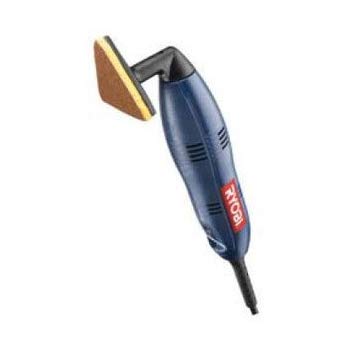
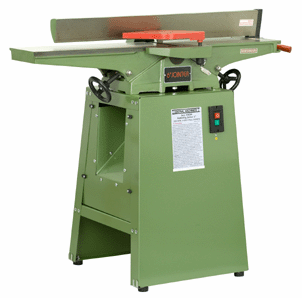
BAD TOOL #3: Harbor Freight 6” Jointer.
No matter how much I messed with this tool, I was never able to get a true 90 degree jointed board out of it.
About the only thing I could do was make shingles with it. Eventually I sold it on craigslist to someone locally. I told him why I was selling it, but he swore he knew how to “make it work right”.
I wished him good luck and then promptly lost hundreds by selling it for just ¼ the price I paid for it.
BAD TOOL #4: Ryobi Benchtop Table Saw
I spent more time tinkering and fixing this tool versus any other tool I’ve ever had!
I was actually glad when the angle adjustment “mechanism” broke (just a plastic rack and pinion). It lasted just one week. But it was one week of deep frustration.
The biggest problem was just overall poor design. The “throat plate” was just a rectangular piece of metal indented on one side to accommodate the 10 inch blade, so one could not make a zero clearance replacement.
And to top it off… it was noisier than ANY other benchtop saw I’ve ever used. Truly like something out of a nightmare!
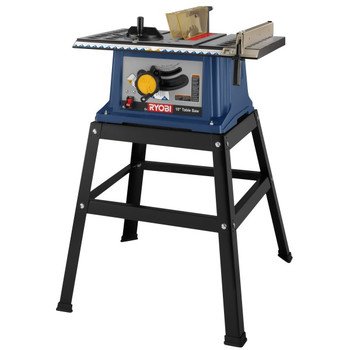
Again these are just some of the bad tools I’ve had. And more than that, bad tools are just one part of the story.
I lost money on tools in a lot of ways during this time (what I call my “tool tryout stage”).
It happened over and over again. And every freakin’ time I thought I knew what to look for… and what to avoid… I lost money again in a different way.
After all my experience… and after coaching hundreds of students and hearing their experiences… I’ve taken note of….
The Ultimate Small Shop Guide
How to set up a complete small workshop on a budget
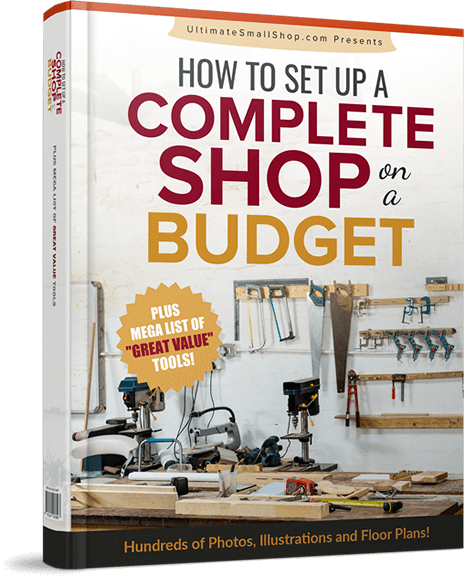
In this detailed guide, I’ll take you by the hand and show you exactly how to setup a FULLY FUNCTIONAL workshop for under $1,000… and do it with very little space.
In fact, if you have just 10’ x 6’ square feet, I promise you can setup a workshop just as great as the $10,000+ ones the experts use.
Inside this 246 page illustrated book there are SIX modules.
One for every area of setting up a home workshop. This includes:
Module #1: Tool Selection
By far the biggest way woodworkers lose money and get discouraged is tool selection. In this module, I’ll show you:

- How to determine exactly which tools you need for your woodworking hobby BEFORE you start buying… so you’ll never blow your hard-earned cash on a tool that just ends up sitting in a box unuse.
- My hand-tool only shopping list if your budget is under $500 (or if you just want to use hand-tools only)… and direct links to buy them for the best price. (pg 41)
- My power tool and hand-tool shopping list if your budget is under $1,000… and direct links to buy them for the best price. (pg 42)
- The 5-second trick that keeps your tools and machines in top working condition. The manufacturers won’t tell you this for a reason! (Do this before and after you start working and you can postpone buying replacement parts for YEARS.)
- My secret source for buying tools at HUGE discounts. I once found a Dewalt DW734 12 ½ inch planer for $170 on this site… when Amazon sold it for $399. And NO ONE talks about this place.
- You’ll get my “short-list” of stationary, portable, and pneumatic tools for your new workshop… and I’ll show you where to buy them at 40-60% off what you’d pay at Home Depot, Wal-Mart, Amazon, or even Harbor Freight!(Go to Page 89 for this eye-opening intel!)
- The best (and really the ONLY) items I would recommend buying at big box stores like Home Depot and Walmart.
- The difference between wood-working with hand-tools vs power-tools. And how to know if a project is better suited for power tools or if hand-tools are the way to go for better precision and control.
- Why shopping for tools through most online and big-box retailers is almost always a waste of money. (There’s a BIG difference between promising low prices… and actually delivering on that promise!)
- My personal “rolodex” of suppliers that offer heavily discounted tools. These suppliers have everything you need – from hand tools, to power equipment, to portable tools and even replacement parts – at the lowest prices I’ve ever seen! (I don’t let many people see this “hush-hush” list.)
The tools I recommend have been used by either myself or someone I personally know. Their durability and performance is top notch and I can vouch for them.
Module #2: Space Selection
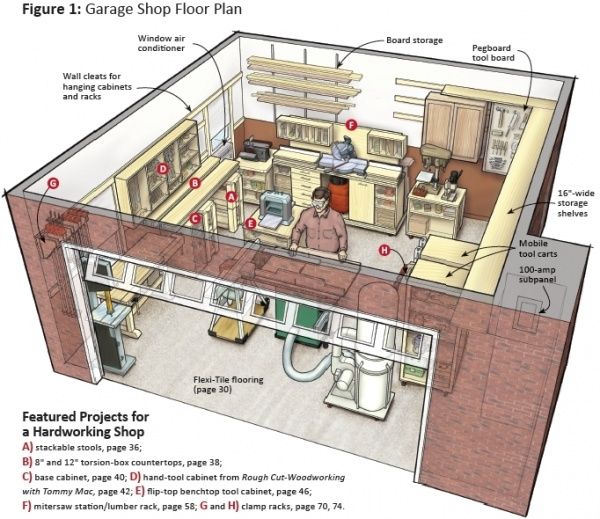
When setting up a long-term shop, you don’t want to screw this up. Get it wrong, and you’ll have all sorts of problems… but get it right, and your life will be much easier. In this module I’ll reveal…
- Starting on Page 11, I’ll walk through all of the possible types of home workshop spaces… and list the pros and cons of each so you can choose the perfect space for your shop.(This has saved my students SO much aggravation and time!)
- You’ll get ideas and layouts for all sizes of workshops, from the large to tiny – including setting up a woodworking shop in your garage, basement, attics, home spaces, apartment corners and more…
- The one place that is perfect for a small workshop… but from what I’ve seen… very few ever consider it!
- The most popular first choice for a home workshop that seems like a good idea at first.. but causes nothing but problems in the long run… (Hint: some things are downright impossible to build in it… and more than that… it can be a real fire hazard!)…(pg 15-16)
- The ONE part of your home that’s very spacious… but is the WORST area for a shop for three very big reasons. (pg 13)
- Why mobile homes should NEVER be used as dedicated workshops. Ignore this and you could easily end up arm-less or on your way to the morgue! (pg 23)
- How to divide your workshop into different areas of your home. This requires more walking around but if you’re really stressed for space this is a god-send idea!
Module #3: Shop Layouts
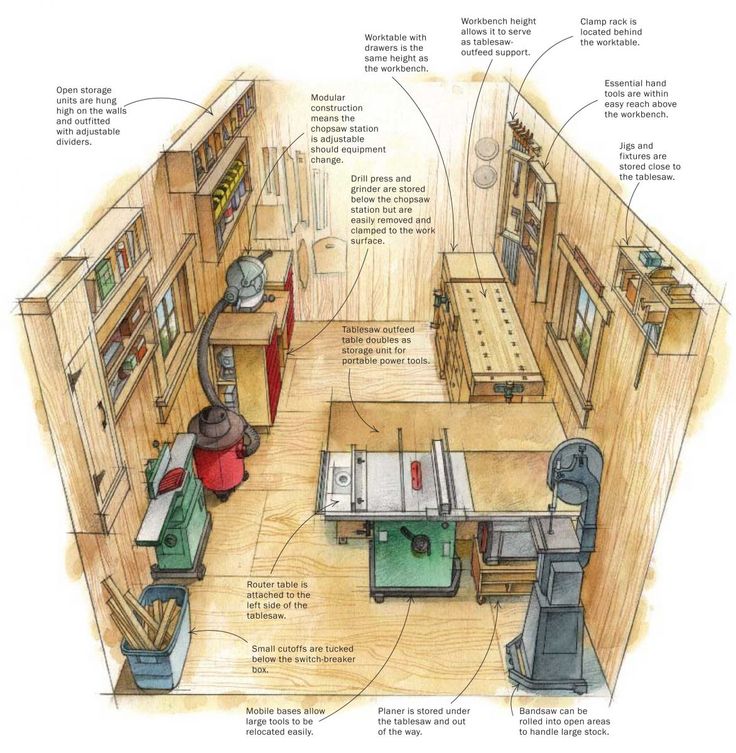
Once you have your location picked out and your tools ordered and on the way… the next step is choosing the best woodworking shop layout for your space.
Inside this module you’ll find:
- How to plan and design your workshop to fit nicely in whatever space you have available… without sacrificing tools and machines you really need. (I’ve built woodworking studios in spaces as small as 7’x7’!)
- Perfect shop layouts for spaces that are 10’ x 10’ or under. (Get drawings and diagrams showing how to position every item in your shop for maximum productivity, safety and enjoyment.)
- What I call the “doorway trick” … using this technique along with a smart layout can make a small space work like a larger one! (pg 29)
- The ONE tool you absolutely need to setup as movable to maximize your workspace… and my exact process for converting any heavy, stationary machine into a mobile one that anyone can move around. (pg 33-35)
- You’ll get detailed floor plans and space-saving layout recommendations for your workshop. It includes machine placement and dividing your work space effectively for different woodworking tasks. (You’ll be surprised what you can do with a tiny or oddly shaped space!)
Module #4: Electricity, Lighting and Sound Proofing

- You’ll learn the ins and outs of lighting and electricity for your workshop, including cost, layout, and whether you should tackle this part yourself or hire a pro. (plus my $40.78 solution to superb whole-shop lighting!) +
- The cheap circuit type that can power almost anything… without ever risking a blown breaker. (pg 89)
- How to sound-proof your shop using the same process singers use to record their music. This will reduce the sound coming from your shop by 50% or more.
- The best time of day to run your loudest equipment. Combine this with my sound-proofing tip and you’ll eliminate the possibility of disturbing neighbors
- How to lower all sound that escapes from your workshop by as much as 70% for under $500.. (The people you live with will thank you, believe me.)
- Speaking of noise… I’ve included a list of low-noise tools to help keep the peace in your home… and all together, they’ll only set you back about $1,000. (Yes, low-noise tools really do exist at budget prices… check out Page 81 to see for yourself!)
Module #5: Heating, Cooling, Ventilation & Dust

Don’t underestimate how important these issues are. They can mean the difference between working in comfort and working in constant irritation. In this module I’ll show you:
- The $3 trick that ensures you have clean air even without inside-to-outside ventilation (which can make your workspace either hot or cold). This trick might even be healthier than having fans in your windows. (pg 195)
- The EXACT model of shop vac I recommend to my students. (this vac is the best performer for its price… a great value!)
- Why “cheap” heaters are not the way to go if you want to save money. And what to do instead. (pg 200)
- The best types of heaters for shops that are well insulated and those that are not well insulted. Read about it from pg 199
- Don’t make this serious humidity mistake when choosing your heating solution. Doing so could ruin your wood stock within hours. Find out what it is on pg 212
- Discover the perfect temperature for long term wood storagef
Module #6: Workshop Safety
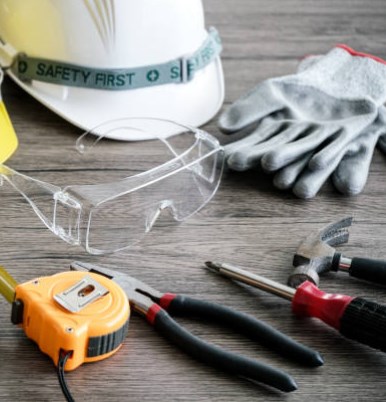
Maintaining and organizing the overall safety of your shop should be your final step in setting up a small shop.
In this part of the guide I’ll reveal:
- The one type of shop fire that gives you a 50/50 chance of losing your home. (Learn about it on pg 220)
- Two tricks to avoid tripping over cables. By far the most common way people get injured in home workshops. More than that… it also ruins your peace of mind always having to be careful where you step. I’ll show you how to solve these issues and achieve both safety and freedom of movement.
- 90% of workshop fires can be prevented by doing this one post-work habit which you’ll discover on page 228
- My 10 item checklist for shop safety. Even experienced wood workers should follow these guidelines… doing so can save your house, your fingers and maybe your life!
- The 4 items that can set your shop on fire faster than you can blink! (This is something all woodworkers must absolutely be aware of)
“This guide represents over 20 years of my woodworking career. It’s the result of my countless mistakes and lessons-learned-the-hard-way”
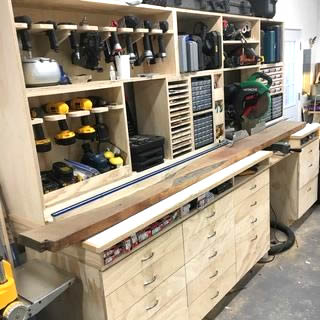
A home workshop that one of our students recently completed.
This is also the guide I wish I had when I was starting out as an amateur woodworker.
But I’m happy that, because you’re investing in the Ultimate Small Shop guide today… you’re going to skip all of the expensive and maddening mistakes I made.
I’ve laid out a step-by-step blueprint for turning your spare space into a workshop without all the hassle and expense.
And now you can use this blueprint to skip all of that frustration.
Instead, you could be working in your own ultimate woodworking shop… within two weeks or less from today.